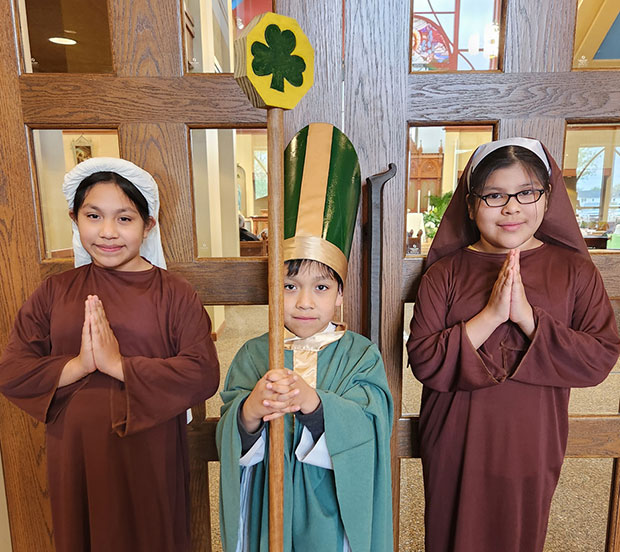
Second- through fourth-grade Religious education students from Jesus Christ, Prince of Peace Parish-Clinton offered a presentation about vocations before Mass on Good Shepherd Sunday. Pictured, from left, are Nathalia Xique, David Xique and Ariana Cuatlatl.
By Dan Ebener and Marti Jewell
For The Catholic Messenger
Of the 40 parishes we interviewed in our study for Catholic Leadership Institute, each one — from every region of the country — was ethnically diverse, meaning they had parishioners from more than one ethnic group. One parish we interviewed had parishioners from 23 Latin American countries. Others had at least 30% membership from two or three ethnic groups.
The work of integrating culturally diverse communities is complex and challenging. These communities might share the same pastor, staff and buildings but they can exist as separate communities. As one pastor of a shared parish told us, “We struggle with multicultural integration, not that there is ill will between the groups, but that they feel siloed because of language and culture.”
Some of the intentional ways to bring people together that we mentioned in our study include: (1) encouraging members, such as parish council members, to become “bridges” (people who attend Mass and social gatherings in both communities); (2) celebrating bilingual liturgies; (3) creating intentional, multicultural, faith-sharing groups; and (4) organizing multicultural festivals, especially around ethnic food.
There is also the question of parish meetings. As one pastor said, “We have Mass in English, Vietnamese and Spanish, but all of our meetings are English-only.” None of the parishes we interviewed mentioned the availability of translators for parish meetings. When the topic came up and we asked whether they provided translation to non-English speakers, the answer was always “No.” In other words, if parishioners did not speak English, they were not able to join the pastoral council or finance council.
In one case, where the parish is about 90% Hispanic and 10% Anglo and a great number of the parishioners are recent immigrants who spoke no English, only two Hispanics are on the parish council and both are bilingual. Only one Hispanic is on the finance council and he is bilingual. When asked if they offered translation at these meetings, they responded, “We tried that, but it didn’t work.” One Anglo parishioner said that she got the impression that the Hispanic community “preferred to let the Anglos take charge” and make decisions about the parish.
On the other hand, some parishes are finding ways to work with diversity in their councils and ministries. In one diverse parish, the pastor, deacon and parishioners all described a model of parish council that is working well for them.
The pastor re-constituted the parish council about a year ago, intentionally placing Hispanics, Vietnamese and African Americans in numbers that represented their parish membership and ensuring that the council is balanced according to age and gender.
In the parishes we interviewed, we heard repeatedly that diverse parishes need leadership that can intentionally care for the diversity in their community. Some begin by building bridges, developing relationships and calling forth new leadership. Some make it a priority to speak/learn the language and understand the customs and culture of all parishioners and the local community. Developing the cultural competence of Catholic leadership is an adaptive strategy needed in our Church today.
(Marti Jewell, associate professor emerita, is a professor, author and researcher of pastoral leadership. Dan Ebener is a leadership professor for the Master of Organizational Leadership program at St. Ambrose University in Davenport and director of Parish Planning for the Diocese of Davenport.)











